
The holiday destination of Agadir, south of Marrakech, is contemporary and fresh, fast developing into Morocco's major resort town. The reason? Agadier's magnificent sandy beaches.Agadier was rebuilt after an earthquake in 1961 which wiped out most of its historic heritage as an important seaport and centre for caravans traversing the Sahara. The rebuilt city has been modelled as a tourist destination and fishing port, favoured by package tours, particularly as a starting point for excursions into the Western Sahara to the south. Agadir has a lovely promenade along the coast and a vibrant restaurant and café culture tailored towards tourists. The nightlife is also fast developing and the shopping scene shouldn't disappoint.Conveniently, Agadir is the city in Morocco most tolerant of foreign customs which helps most tourists feel most comfortable, and helps to ease them into the their travels further into the country. The town is conveniently located near popular attractions such as the walled city of Taroudannt and the Massa Lagoon, and contains a number of luxury hotels and excellent golf courses. Agadier makes for either a comfortable start to a Moroccan journey, or useful respite for those who have already seen much of the country already.
Aït Benhaddou is an ancient fortified city (ksar) situated along the former caravan route between the Sahara and Marrakech. It is certainly one of the most breathtaking tourist attractions in Morocco. A UNESCO World Heritage Site, Aït Benhaddou is not only a place of great historical significant that stands as a record of Maghreb architectural practices, but is so immediately evocative of the most romantic visions of ancient Arabia that visitors may mistake it for a fanciful mirage. The buildings, constructed against a mountain and surrounded by steep defensive walls, are all built from moulded earth and clay brick, and the sight of them, ornamented with decorative motifs and appearing blood-red in the evening light, is so stirring that Aït Benhaddou has been featured in numerous Hollywood films (from Lawrence of Arabia to Gladiator). Providing some picture-perfect examples of kasbahs and medinas, no trip to Morocco would be complete without a visit to Aït Benhaddou. The city is most picturesque at sunrise and sunset, so visitors should remember to pack their cameras. Aït Benhaddou is a 3.5 hour drive south east of Marrakech.
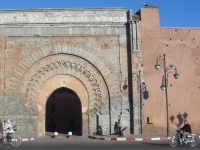
Bab Agnaou is one of the 19 gates of Marrakech and was built in the 12th century, in the time of the Almohad Dynasty, and stands the innermost and most ornate of the city's gates and was one of the first stone monuments built in Marrakech.The colour of the stone seems to change drastically depending on the light, weather and time of day, and the bas-relief is sophisticated and still impressive to this day. Experts believe that the function of the gate may have been nationally symbolic, as suggested by the corner-pieces which are decorated with floral designs, framed by three panels with inscriptions from the Quran.Bab Agnaou is also a geographically convenient sight for tourists exploring the city as it forms the entrance to the royal kasbah in southern Marrakech. The kasbah, built by the Almohad sultan Yaqub al-Mansour, is home to the El Mansouria Mosque, the El Badi Palace and the Saadian Tombs, all magnificent tourist attractions, making this a part of the city that seldom goes unexplored for visitors. Of all Marrakech's gates Bab Agnaou is generally acknowledged as the most picturesque and it is included in almost all the walking and sightseeing tours of the area.
Address : Entrance to the medina (ancient Moorish quarter) on Route dOurika.

The Ben Youssef Madrassa was once an Islamic college in Marrakech named after Sultan Ali ibn Yusuf, who expanded the city considerably. This madrassa was one of the largest theological colleges in North Africa and may have housed as many as 900 students.After being closed down in 1960, it was refurbished and reopened in 1982, an interesting attraction for the value of its educational influence, but mostly thrilling for tourists because of the stunning architecture and mosaics. The courtyards and patios are richly carved in marble, cedar and stucco, with intricate geometric patterns and Islamic inscriptions. The Ben Youssef Madrassa is often ranked as one of the best attractions of Marrakech. Visitors can explore the student study rooms and dormitories. Luckily, photography is permitted, because it is one of the most spectacular buildings in Morocco.Although centrally located, the madrassa can be difficult to find, partly because various touts sometimes mislead tourists for reasons of their own, often trying to redirect them to family-owned stores and the like. It is better to rely on a good map and take directions from locals with a pinch of salt.
Address : Kaat Benahid, Marrakech 40000, Morocco
E-mail : [email protected]
Website : www.medersa-ben-youssef.com/en/
Telephone : +212 5244 41893
Opening times : 9am-7pm (until 6pm in winter).
Admission : MAD20
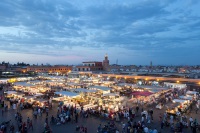
What it lacks in beauty, the large town square of Marrakech, Djemaa el-Fna (Square of the Dead), makes up for with a pulsating liveliness that belies its name.Every day the square is a colourful circus of performing artists including snake charmers, musicians, storytellers and healers who vie with each other to be noticed by the milling crowds. Every evening food stalls take over and the competition is fierce among them for the passing trade, with everything from boiled snails and sheep's heads to thick vegetable soup, kebabs or fresh salads on offer. Freshly squeezed orange juice stalls stand side by side encircling the market and offer a refreshing drink both day and night.The square is a fascinating place to be a while relaxing at of the surrounding cafes and watching the swirling parade. The square is also the gateway to the souks (bazaars) of Marrakech, tucked away in the surrounding labyrinth of narrow streets and alleys. It is easy to lose your way, but well worth exploring. Bargain for anything from water mugs and dates to famous Moroccan carpets. Mercifully, the souks are also well shaded from the searing Moroccan sun and offer respite from the heat.
Address : Derb Chtouka, Marrakesh 40008, Morocco.
E-mail : [email protected]
Website : http://www.jemaa-el-fna.com/en/
Telephone : +212 648 284465
Transport : The square is most easily accessible by foot and taxi.
Opening times : Open 24 hours a day.

The El Badi Palace('the incomparable palace') consists of the remnants of a glorious palace built by the Saadian King Ahmad al-Mansur, in 1578. The original building is thought to have had about 360 rooms, a courtyard and a pool, and was decorated with Italian marble and large amounts of Sudanese gold. It also had a small, underground jail where the king kept his prisoners. The design of the palace was influenced by Granada's Alhambra, but the original palace was torn apart by Sultan Mawlay Ismail.Today, the once luxurious palace is a ruin consisting of some intact rooms and numerous walls, terraces, gardens and foundations. The underground jail can still be explored and there are a number of beautiful mosaics surviving, but visitors have to use some imagination to conjure up the onetime grandeur of the place. The ruins still retain some their romance, but very little effort has gone into maintaining or preserving the site. Despite the ramshackle nature of the attraction anybody with an interest in history and archaeological sites should enjoy exploring the site. There is little or no shade so travellers should go prepared for the sun and should avoid the hottest part of the day. There is a small admission fee.
Address : Ksibat Nhass, Marrakesh, Morocco.
E-mail : [email protected]
Website : www.palais-el-badi.com/en
Telephone : +212 5243 78163
Transport : Like much of Marrakech, a short walk or shorter taxi ride are the most convenient options.
Opening times : 8am-5pm every day.
Admission : About MAD 10.
The popular holiday resort town of Essaouira dates from the 18th century and is easily reached by bus from Marrakech. The town is encircled by a fortified wall and faces the sea, featuring a beautiful stretch of beach, some pretty whitewashed houses, boat-builders workshops and art galleries. What makes Essaouira popular is the laid-back holiday atmosphere, and the reliable coastal wind which makes it a perfect place for wind-reliant watersports like kite surfing; although the wind can make sunbathing and swimming more difficult. It is also famed for its woodcarving tradition, particularly due to the appeal of the local fragrant Thuya wood, which ensures that some gorgeous souvenirs can be found.Other popular activities in Essaouira include horseback riding on the beach, visits to the Argan Woods and Thuya Forests, and excursions to nearby Diabat, which draws tourists mainly on the strength of Jimi Hendrix's presence there many years ago. The harbour of Essaouira is a hive of activity, with stalls and open air seafood restaurants, and is particularly busy during the daily fish auction that attracts as many seagulls as buyers, sellers and onlookers (there is no fish auction on Sundays). The area is thought to have been inhabited since prehistoric times and is dotted with archaeological remains: Mogador Island, just off the coast, boasts the ruins of a Roman villa.
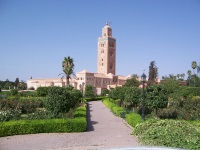
Towering over the labyrinthine streets and markets of Marrakech is the city's principal landmark, the minaret of the Koutoubia Mosque, known as the 'mosque of the booksellers' because of the bazaar of book traders that used to be nearby.The red stone mosque was first built in 1147, but demolished and rebuilt in 1199 because it was not correctly aligned with Mecca. The mosque has 17 aisles and 112 columns, and room for thousands to pray within. The ornately carved minbar (pulpit) is believed to have been a gift from the Almoravid Sultan Ali Ben Youssef. The minaret is 221ft (69m) high and consists of six chambers one atop the other, ascended by a ramp through which the muezzin rises to the top balcony.The mosque, as a sacred place of worship, is unfortunately closed to non-Muslims, but the gardens and the general area around it is a wonderful place for an evening stroll. The minaret is perhaps at its most beautiful when lit up at night, but is best for photographs at sunset, when the red stone glows. Hearing the call to prayer of this ancient mosque is a particularly special experience.
E-mail : [email protected]
Website : www.mosquee-koutoubia.com/en/
Opening times : Not open to the public.

The Majorelle Garden is a botanical garden designed by the French artist, Jacques Majorelle, in 1924. Previous owners have included Pierre Bergé and Yves Saint-Laurent (whose ashes were scattered there when he died in 2008). The garden is also home to the Islamic Art Museum of Marrakech, which houses an exhibit of North African textiles from Saint-Laurent's personal collection, and paintings by Majorelle.The garden is home to more than 15 bird species endemic to North Africa, and full of ponds and water features. The garden took 40 years to create. It is one of the most popular tourist sites in Morocco and a must for all visitors. The villa in the centre of the garden, which houses the museum, is a stunning blue, accented with other bright colours, a mixture of classic Moroccan features and art deco creativity. This is a particularly good attraction for a hot day as the gardens are shaded and always seem much cooler than the rest of the city. There is a lovely café in a shaded courtyard for refreshments and a gift shop selling YSL products, among other things. Although the gardens can be explored in under an hour, this is a place that can be enjoyed for a few hours, escaping the bussle of Marrakech.
Address : Rue Yves Saint Laurent، Marrakesh 40090, Morocco
Website : www.jardinmajorelle.com
Telephone : +212 5243 13047
Opening times : Opening times vary according to season: October to April, 8am to 5:30pm; May to September, 8am to 6pm; and during Ramadan, 9am to 5pm.
Admission : MAD 70 (garden), MAD 30 (museum). Concessions are available.
The village of Ouirgane, in the foothills of the Atlas Mountains, about 90 minutes' drive from Marrakech, stands at the centre of a popular resort area, where summers are cooler and winters less harsh than those experienced in the city. The surrounding Berber countryside offers picturesque villages and hamlets to explore, set in pine forests full of wildlife and groves of fruit trees, alongside streams cascading down from the High Atlas Mountains and fields of wild flowers. The soil is a striking red, which emphasises the luxuriant greenery and makes the landscapes slightly otherworldly in some lights. The area is also known for its extraordinarily beautiful rose gardens.The village is mainly just used as a peaceful place to relax, and as a hub for outdoor activities like hiking, mountain-biking and horseriding. There are a few attractions in town, however, including the Tin Mal Mosque, what remains of the somewhat ruined old kasbah, and a small souk (market) every Thursday, which is noted for its traditional Berber pottery. The mild climate is what makes Ouirgane a year-round attraction, the best time to visit the town and surrounding area is between March and May, or between mid-September and December.

A ski resort in the desert! Thick snow envelops the Jebal Oukaimeden mountain peak during the winter months (usually January and February), just a 46 mile (74km) drive from Marrakech. The town of Oukaimeden, which can be reached by taxi or car, is well-equipped with the basics for skiers, with restaurants, ski equipment to rent, comfortable hotels set in lush greenery and backed by blue mountains, as well as ski schools for beginners.Skiers can ascend the mountain by donkey or camel, but there are also some modern ski lifts. Five ski runs traverse down from the dizzying heights of Jebel Attar and there are nursery slopes and some intermediate runs. The ski equipment for rent can be somewhat outdated and visitors should be wary of renting from unofficial shops. At the top of the chair lift young men typically vie for jobs as guides down the mountain and many visitors choose to hire them for at least one run because the routes are difficult to discern.Oukaimeden is one of the best ski resorts on the African continent, although of course there is not much competition. The resort is tiny and the facilities very basic compared to European equivalents, but there is a lot of fun to be had at Oukaimeden. The resort is notably Moroccan in style and this gives it an eccentric feel for those used to European ski resorts. A lot of development is due to begin at Oukaimeden, which will no doubt make it more typical, and more convenient.

The beautiful necropolis was built by the Saadian Sultan Ahmed el Mansour in the late 16th century as a final resting place for him and his successors. Having fallen into disrepair, the tombs were rediscovered in 1917 and carefully restored to their former splendour. There are 66 indoor tombs, lavishly decorated with colourful, intricate mosaics. The central mausoleum, the Hall of the Twelve Columns, is exceptionally ornate with a high, vaulted roof, furnished with stunning carved cedar panels and columns of grey Italian marble. The tombs are spread through three rooms and there are gardens outside the building where the graves of soldiers and servants can be seen. The Saadian Tombs are a remarkable tourist attraction but they don't require much time and can be fully appreciated in under an hour. The tombs are a stop on many sightseeing tours.
Address : Rue de la Kasbah near the city walls in the old city.
E-mail : www.tombeaux-saadiens.com/en/[email protected]
Telephone : +212 654 572205
Opening times : 9am-4pm, every day.
Admission : About MAD 70 is charged for entry.
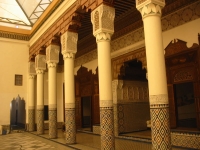
The Museum of Marrakech is located in the Dar Menebhi Palace, built at the end of the 19th century by legendary Mehdi Menebhi, in the old centre of Marrakech. The palace was restored by the Omar Benjelloun Foundation and converted into a museum in 1997. The house itself is representative of classical Andalusian architecture, with fountains in the central courtyard, numerous carvings and beautiful tiles. The museum holds exhibits of both modern and traditional Moroccan art, as well as historical books, coins, pottery and other Berber artefacts.The convenient location and interesting building make this a worthwhile stop even for the museum-phobic and it is one of the most popular attractions in the city; in fact, the exhibitions may not overly impress, but the intricate mosaics and other interior features should. Regrettably, for genuine art lovers, and those interested in the historical artefacts, there is little information provided in English, so the appreciation must be largely visual. There is a gift shop selling prints of some of the art and photographs on display in addition to a little café for refreshments. Photographs are permitted inside the museum.
Address : Place Ben Youssef, Medina.
Website : www.museedemarrakech.ma
Opening times : 9am to 6:30pm daily.
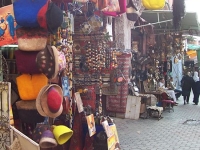
Marrakech is home to a labyrinth of bustling souks(workshops and markets) offering the city's most fascinating wares. Whether shopping or simply exploring, they are a must for any visitor.The northern end of the souks, best accessed from the Ben Youssef Mosque, remains refreshingly unspoilt with blacksmiths making wrought-iron goods and alleys filled with the distinct odour of leather workshops. The stalls emerge further south and are met by the Rahba Kedima, a market famous for its bizarre offerings of animals and eccentric potions for spells. The market is colourful and crowded with plenty of fodder for keen photographers.There are bargains to be found if you haggle hard. As a rule of thumb, your first offer should be around half the price they ask for. A fair price is whatever you're happy paying. The souks are a wonderful experience and many foreigners visit repeatedly during their stay, but it is advisable to stay vigilant and keep an eye out for pickpockets. A firm but polite 'no thank you' is usually enough to ward off pushy stall holders.
Transport : The souks are best explored on foot.

The Todra Gorge, a canyon on the eastern side of the High Atlas Mountains, is undoubtedly one of the most spectacular natural attractions that Morocco has to offer. Nature lovers who feel starved in the choked streets of Morocco's cities can simply take the trip to the Todra Gorge (most easily accessed from the town of Tinerhir) where they will be rewarded by the experience of a lifetime. To put the grandeur of the gorge into perspective, consider that over its final 1,950 feet (600m), the canyon narrows to a rocky passage only 33 feet (10m) wide, while the sheer walls rise up 984 feet (300m) on either side.Sunlight only reaches the bottom of the Todra Gorge, where an ice-cold river flows, for a few hours each morning, and night-time temperatures regularly fall below freezing. Although a place of awesome ruggedness, tourists need not worry about being too far 'off the beaten track' as a well-maintained hiking path runs through the gorge, and there are restaurants and even a hotel situated about halfway along. In fact, those in search of a tranquil wilderness may be disappointed as the gorge's popularity ensures that it is sometimes quite crowded. Climbing is a popular activity in the gorge and several adventure tour operators offer climbing trips and equipment.

Travel Guide powered by Word Travels, copyright © 2023 Globe Media Ltd. By its very nature information in this travel guide is subject to change at short notice and travellers are urged to verify information on which they're relying with the relevant authorities. Neither Globe Media Ltd nor Travel Vogue can accept any responsibility for any loss or inconvenience to any person as a result of information contained above.